The Samsung 850 EVO 4TB SSD Review
by Billy Tallis on July 11, 2016 10:00 AM ESTAnandTech Storage Bench - The Destroyer
The Destroyer is an extremely long test replicating the access patterns of very IO-intensive desktop usage. A detailed breakdown can be found in this article. Like real-world usage and unlike our Iometer tests, the drives do get the occasional break that allows for some background garbage collection and flushing caches, but those idle times are limited to 25ms so that it doesn't take all week to run the test.
We quantify performance on this test by reporting the drive's average data throughput, a few data points about its latency, and the total energy used by the drive over the course of the test.
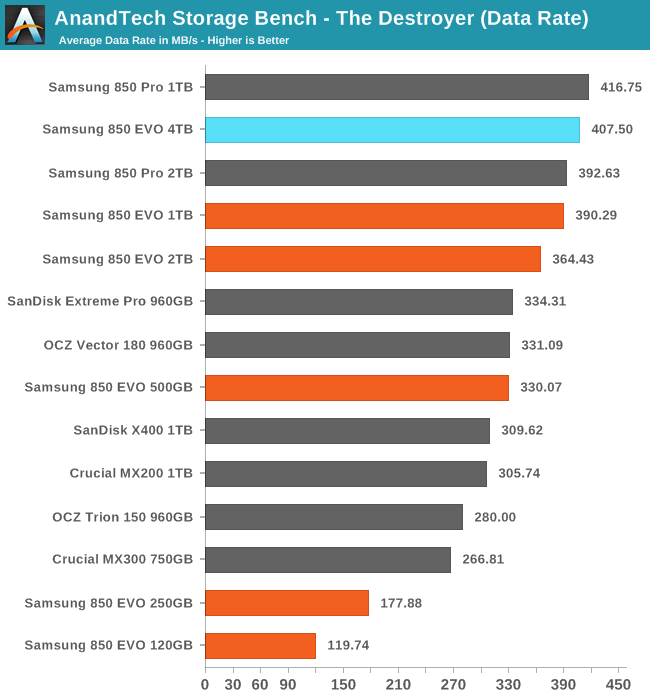
The Destroyer isn't enough to really challenge the 4TB 850 EVO, as this test doesn't write enough data to fill the drive even halfway. The 1TB 850 Pro still holds the record for the highest average data rate maintained by a SATA drive, but the 4TB EVO is closer to that than to any slower drive.
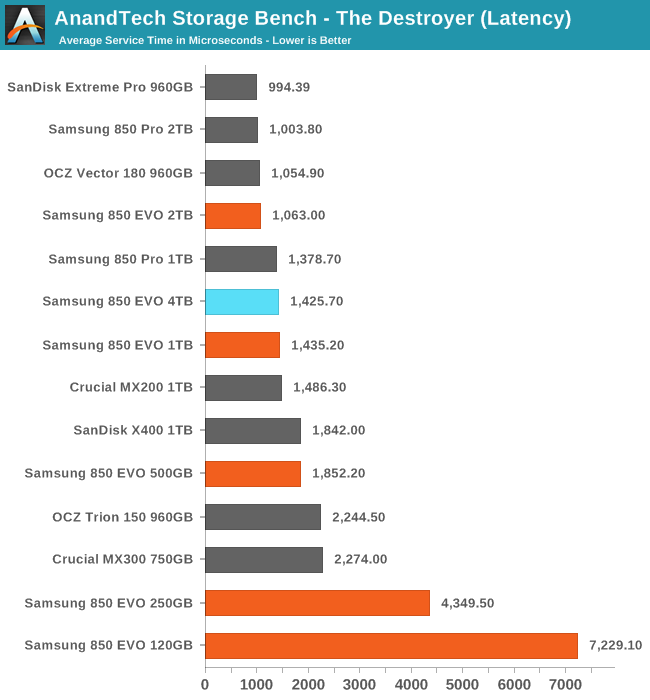
After the 2TB 850 Pro and EVO managed to tie with the top tier of drives for average service time, it is a little disappointing to see the 4TB 850 EVO only manages to match the 1TB models, but that's still high-end performance.
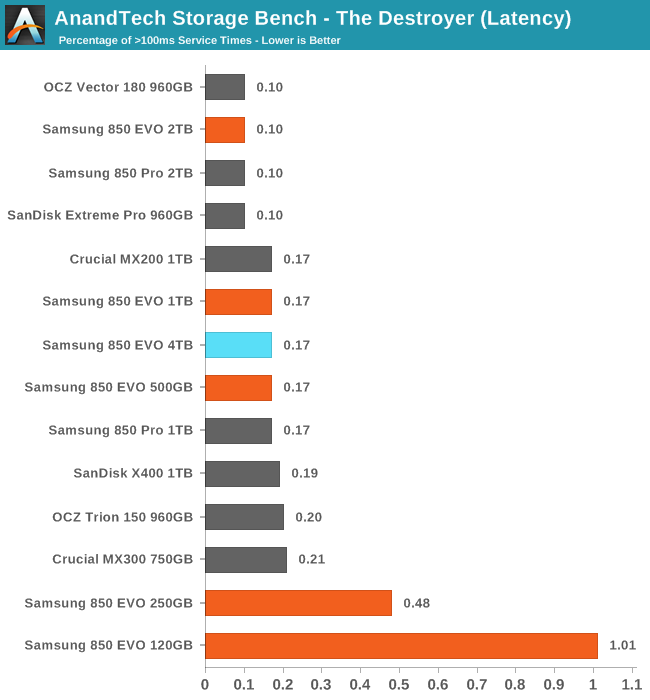
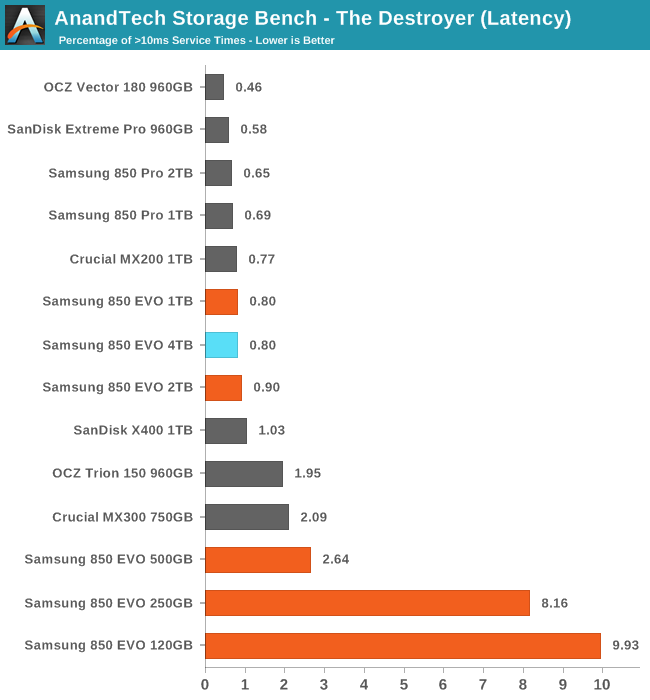
The 4TB 850 EVO has slightly more extreme latency outliers than the 2TB 850s, but at the more strict threshold of 10ms it is tied with the 1TB 850 EVO for being the best TLC drive.
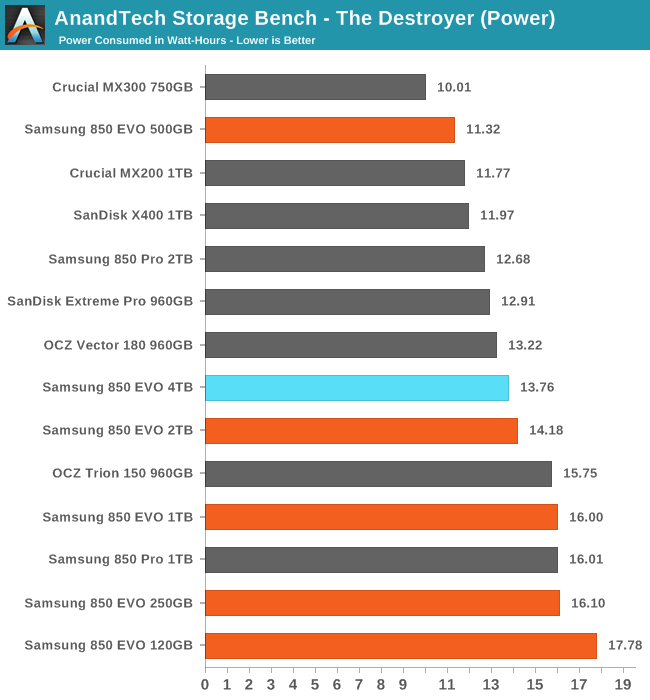
The 4TB 850 EVO brings a little more reduction in power use over the 2TB 850 EVO, which substantially cut power use relative to the 1TB model. The 4TB drive is clearly not paying any significant penalty for keeping so much flash and DRAM powered up.










145 Comments
View All Comments
jardows2 - Monday, July 11, 2016 - link
What is the use case for this drive? $1500 for mass storage? Price per GB may be comparable to smaller drives, but that is still a huge chunk of change to get, what?It's a consumer drive, not an Enterprise drive. Video and Photo editors are going to hit it hard, so the lower endurance rating is going to hurt it for use in those applications. All I can see is that it is a halo product to push the industry forward, purchased only by those who have lots of spare cash to spend. Am I missing something?
ddriver - Monday, July 11, 2016 - link
RAW photos, audio, video, basically any kind of data acquisition - those eat a lot of capacity. At 1500$ I'd argue this is not a consumer but a prosumer product.vladx - Monday, July 11, 2016 - link
This type of product is for people rich enough to not care about the price. Simple as that.MScrip - Monday, July 11, 2016 - link
I'd say video editing. It's not uncommon to come home with a terabyte of footage from multiple 4K cameras over multiple days of shooting. And you may be editing multiple projects at a time.This would make a hell of a media drive... fast and local.
And when you're done with the projects... you move them to slower mass storage for safekeeping.
jardows2 - Monday, July 11, 2016 - link
My point being, if you are a hobbyist, $1500 is a huge entry point, especially when the, albeit slow, hard drives come in a just a couple hundred dollars.If you are a professional, you are going to want Enterprise level drives with the endurance and warranty support. But if you are using multiple cameras shooting 4K footage, you probably have so much invested there, that $1500 for a storage drive isn't a huge percentage of the overall equipment budget. For me, I'm just using a 1080p camcorder for now, so my budget is way lower!
MScrip - Monday, July 11, 2016 - link
I'm mostly 1080p... with occasional 4K. I don't need this 4TB drive... but I've got my eye on the 1TB version. Right now I'm editing on a 1TB WD Black... and its slowness shows!Is $1500 expensive? It depends. It's just a bigger version of the 2TB model... which is a bigger version of the 1TB model... etc.
Drives in higher capacities always cost more money... especially the first of its kind (4TB in a single SSD)
Asking "who is this for?" is usually a difficult question. My best guess... I'd say it's for someone who wants a single SSD... but needs to hold more than 2TB. :)
Impulses - Monday, July 11, 2016 - link
Moved to 2x 1TB 850 EVOs myself a while back (with an SM951 256GB for OS/apps), can't wait until the higher capacities come down in price... Depending on how much of a premium the 4TB sustains over time I could see myself adding one (or two) 2TB or just going straight to 4TB.Mostly working with 1080p and relatively small 16MP RAWs... Bought the 1TB before the 2TB was readily available but I don't really regret that bit, higher seqs when going to the SM951 and easier to repurpose them later on.
Silh - Monday, July 11, 2016 - link
One use case, which is admittedly niche: musicians using virtual instruments.Instrument sample libraries can run into the multi-gigabyte range (have ~2gb in total myself, and I'm only a hobbyist), and are built up of recordings of instruments playing single notes in various volumes, styles, etc., depending on the library's level of detail sometimes recordings of the transitions between notes.
Less detailed virtual instruments may only eat up a few hundred MB in samples; it's not a huge deal to load the entire thing into memory for those. However, more detailed ones can run in the tens of GB's per instrument for all the different layers, and once you start building up an entire virtual orchestra, you will have to resort to loading them from the disk during playback, and for that you require something with low latency and high throughput... hence the use of SSD's. Don't even need the write endurance in a case like this, even.
ddriver - Monday, July 11, 2016 - link
Nah, you really want samples loaded in RAM. RAM is cheap, even a modest DAW system will have at least 16 gigs of ram. Latency really matters here, and RAM latency is much, much lower than SSD, and sample libraries aren't that big. Sure, there are a few libraries in excess of 30 GB, but you really use a much smaller subset of the whole thing at a time.Silh - Monday, July 11, 2016 - link
It really depends on which sample libraries you're using, and some of the big ones get quite huge. The (perhaps now mere) 32gb RAM on my system only can hold so much, especially with some of the big EastWest libraries.The other advantage of course, is that I can load my entire template in a matter of a couple of minutes instead of waiting 15 minutes for it to load off a regular HDD.